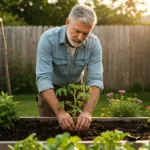Comprehensive Guide To Starting Peppers Indoors
Starting peppers indoors can be a rewarding experience, allowing you to get a head start on the growing season and enjoy fresh peppers sooner. This guide provides a comprehensive overview of the process, from seed starting to transplanting, drawing on expert advice for optimal results.
Seed Starting Mix
When starting pepper seeds indoors, it’s essential to use a seed starting mix rather than soil from outdoors.
Outdoor soil can harbor fungus and insects that can harm young seedlings. A bagged, sealed product like Jiffy starting mix is recommended.


Even with a sealed mix, fungus gnats may be present, as they have a strong ability to lay eggs. To mitigate this, you can try pouring boiling water into the mix to kill off any eggs. Another option is to add neem oil, which disrupts the growth of potential fungus or insect eggs. You can also microwave the mix.
Before planting, pre-moisten the seed starting mix. Dry mix doesn’t draw in water well, so adding water before planting helps ensure proper hydration of the seeds.
When setting up the seed trays, fill each space with the pre-moistened mix, pack it down with your thumb, and fill it again. Do not add fertilizer at this stage. The seed itself provides enough nutrients for germination.
Before planting, pre-moisten the seed starting mix. Dry mix doesn’t draw in water well, so adding water before planting helps ensure proper hydration of the seeds.

When setting up the seed trays, fill each space with the pre-moistened mix, pack it down with your thumb, and fill it again. Do not add fertilizer at this stage. The seed itself provides enough nutrients for germination.
Plant two seeds per space in the seed tray. If you are only planting a few seeds, you can also use a cup or container, which will allow you to skip the transplanting from a small cell.
Press the seeds into the mix to a depth of about a quarter to a half inch, as pepper seeds will germinate at any depth. Cover them with more mix, label the tray with the pepper variety and date, and you are ready for the next step.

Germination
Pepper germination times can vary from 7 to 21 days. Some varieties may germinate quicker than others. Don’t be discouraged if some seeds take longer than others.
Peppers prefer a warm environment to germinate, ideally around 70-75°F. A heat mat can be used to raise the temperature to about 80°F, which will speed up germination.
Once the seeds break the surface, usually in 2-3 days with a heat mat, the heat mat can be turned off, assuming the room temperature is around 70°F.
Peppers need adequate light, even at the germination stage, so ensure the grow lights are on for 18 hours a day for the first week or so after they have germinated. This will help prevent them from growing leggy.
Watering
Bottom watering is the preferred method for watering pepper seedlings. This involves filling the tray with water and allowing the soil to absorb it from the bottom. This method prevents splashing, which can displace seeds or spread disease and fungus.
Watering frequency can vary from one to five times a week. It depends on the plant size, temperature of the grow lights, and environmental conditions. Monitor the top of the soil. When it becomes light brown, it is time to bottom water. Allowing the top of the soil to dry out also disrupts the growth cycle of disease and fungus.


Lighting
Adequate light is critical for healthy growth. If plants do not get enough light, they become tall, thin, and leggy.
Keep grow lights above the plants. After the first week of 18 hours, reduce the light to 12-16 hours a day. This will encourage stocky growth.
Acclimation
Acclimation is the process of gradually introducing indoor-grown plants to the outdoor environment. This is essential to prevent stress from the sun, wind, and cold.
One way to acclimate young seedlings is to take them outside for an hour each day or every other day, if the weather permits
If you are not able to start acclimation early, it will be necessary to slowly introduce them to the outdoors over the course of a week. Start with just 15-20 minutes of outdoor exposure on the first day, and increase the time gradually each day. Cloudy days allow for longer outdoor time.
Fertilizing
Wait until the plants have developed their first set of true leaves before fertilizing. True leaves are the second set of leaves that grow on the plant. Use a liquid fertilizer at half or quarter strength, once a week. A low fertilizer with an NPK of around 5-5-5 is suitable.
Processed chemical fertilizers can be used. Plants do not have a preference, and at this stage there is no soil life, so chemicals will not harm the microbiology in the soil. Avoid over-fertilizing, as too much can be detrimental.


Transplanting
When the roots begin to curl at the bottom of the container, the plants are ready to be transplanted into larger containers. This usually happens at about 5 weeks old.
Use an 8 oz cup for transplanting. You can use recycled containers or plastic cups. Label each cup with the pepper variety and starting date.
At this stage, it is appropriate to use bagged potting soil. At this point the plants will be going outdoors soon, so any insects that come with the soil will not be a problem. You can continue to use a seed starting mix if you prefer. You can mix neem oil in the starting mix to help deal with fungus and disease.
Fill the new container, make a depression in the middle, and gently remove the seedling from the seed tray. Place the seedling into the new container. Add more soil, make sure to poke holes in the bottom for drainage.
Topping
When the plants are still indoors and have 3-5 weeks left before going outside, you can top them off. Topping is the process of pinching off the growing tip of the plant. This will encourage the plant to grow more side shoots, resulting in a stockier plant with more blooms and more peppers.
Not all peppers benefit from topping. It is best for most peppers but avoid topping bell and banana peppers.
Final Transplanting
The final transplant into the ground should not happen until the ground temperatures are at least 50°F at night and 70°F during the day. Continue to acclimate the plants to the outdoors before final transplant. Growing plants indoors for 8-12 weeks gives you a head start on the growing season, and helps ensure a healthier harvest. By following these guidelines, you can successfully start pepper plants indoors, giving them the best start for a bountiful harvest.



